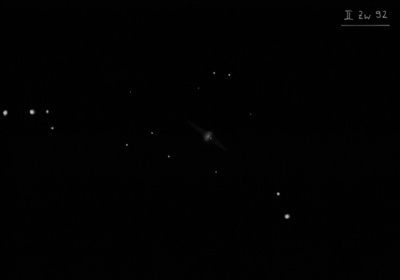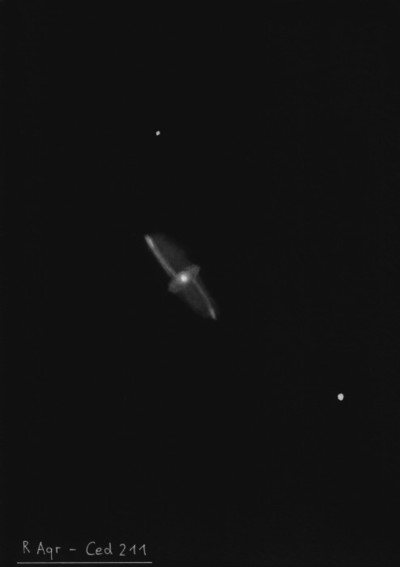The extensive and inconspicuous constellation of Aquarius lies almost entirely in the southern sky, below Pegasus, between Pisces and Capricornus. It consists of only moderately bright and faint stars, arranged relatively irregularly, forming no distinct shape. The Sun's transition into Aquarius marked the arrival of rainy weather for ancient peoples in the eastern Mediterranean and the Middle East. Currently, the Sun passes through Aquarius from February 16 to March 11, making it a typical constellation of autumn evenings. With the naked eye, a small group of orange stars known as ψ AQR may catch your attention in the constellation, creating a false impression of a looser star cluster. Also notable is the pitcher or "Aquarius's pitcher" located on the celestial equator, represented by four stars: η, π, γ, and ζ Aquarii arranged in the shape of the letter Y. Only a few other stars deserve special attention. As the constellation is farther from the Milky Way, it naturally lacks star clusters and nebulae. However, it contains three interesting globular clusters, two of which are in the Messier catalog, and two well-known planetary nebulae—Saturn and Helix. The most numerous deep-sky objects are galaxies, although most of them have low brightness.
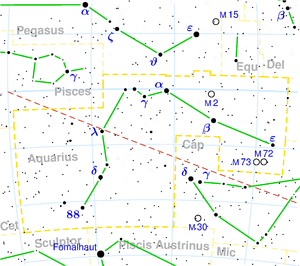
ψ Aqr - The main star with a brightness of 4.5 mag has a companion of 9.4 mag at a distance of 49". In a 10cm telescope, it appears as a wide, unevenly bright pair consisting of an orange and greenish component, resembling the planet Uranus. Very nice color contrast.
Dzeta Aquarii (ζ Aqr) - The well-known binary star in the Aquarius constellation. The two almost equally bright components with magnitudes of 4.3 and 4.5 have a period of mutual orbit determined to be 856 years. In 1967, the stars were only 1.7" apart, but since then their separation has slowly increased. In 1985, it was 1.8", but at the beginning of the third millennium, we perceive them as a yellow to white pair, approximately two arc seconds wide, easily distinguishable even with a small telescope with a 5cm objective diameter. In the year 2160, their separation will increase to 6". The system is located 92 light-years away.
94 Aqr - An easily distinguishable and beautiful double star, composed of two components with magnitudes of 5.3 and 7.3, separated by 12.7", so even a small telescope is sufficient for resolution. One has a nice reddish-yellow hue and the other has a light green shade.
41 Aqr - A binary star composed of two components with the same brightness of 7.1 mag at a separation of 5". In the field of view of a telescope with an objective diameter of around 20 cm, it appears as a tight, equally bright pair of golden and blue components.
53 Aqr - Multiple star. In a 200 mm telescope, a close pair (3.1") of two yellow stars (6.4mag, 6.6mag), which are not related at all - they are just an optical double star. Nearby, two fainter stars are also visible, with magnitudes of 12.9mag and 13.9mag.
R Aqr - Variable star, whose magnitude can sometimes reach a value of up to 5.8mag, although it is usually much fainter. It exhibits rapid, unpredictable fluctuations.
NGC 7293
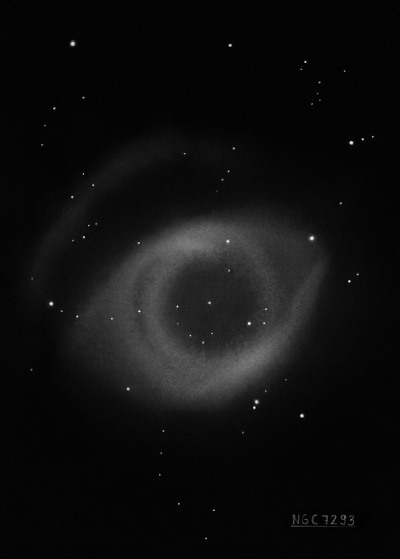
15x50 IS binoculars (8/27/11): easily visible in binoculars using a pair of narrowband filters.
Karl Ludwig Harding discovered NGC 7293 = Au 48 around 1823-24 at Gottingen University Observatory, probably using an 8.5-inch reflector built by William Herschel. According to Wolfgang Steinicke, Harding published a list of 8 new nebulae in Astronomisches Jahrbuch, although the Helix Nebula is the only object he actually discovered, the others being observations of previously discovered nebuae. Harding's list was not checked until 1857 by Winnecke, so the Helix was not generally known. Ernesto Capocci independently discovered this huge planetary in late 1824 at Capodimonte Observatory in Naples, but his position was over a degree too far west and the object wasn't found or generally known by others. In 1856, Christian Peters reported another discovery while he was at Capodimonte Observatory around 1850 (AJ 2, p16). As late as 1884 Jermaine Porter also reported a discovery, although at that point it was already in the GC. Both Herschels missed finding this planetary, probably due to its large size.
Based on a September 1912 photograph (4 hour explosure) taken with the Crossley reflector at Lick, Heber Curtis wrote "I would suggest that this interesting object be referred to as "The Helical Nebula in Aquarius" [to distinguish it from the the Helical Nebula in Draco, NGC 6543]. In 1917, Robert Innes, at the Union Observatory in Johannesburg, noted it was "seen in both the 3-inch and 9-inch telescopes. Large, but no detail." and probably based on Curtis' comment, he referred to it as the "Helical nebula in Aquarius."
200/250mm - 8" (10/4/80): huge annular planetary is fairly bright at low power using a Daystar 300 filter. The rim has an irregular surface brightness.
300/350mm - 13.1" (8/15/82): the "Helix" nebula is extremely large, about 15' diameter, clearly annular. Significant contrast gain with OIII filter permits observation even from the Bay Area. The fairly bright rim is non-uniform appearing brighter along the north side. About seven stars are superimposed including the mag 13.5 central star. Appears best at low power due to size and relative low surface brightness. Easy in the 80mm finder.
400/500mm - 17.5" (10/2/99): gorgeous view at 100x and OIII filter. This huge, annular PN is 15'x12' in size and slightly elongated E-W due to an extension on the west side. The thick annulus is mottled and irregular with brighter regions along the N, NE and SW edge. The west side is slightly weaker but very faint extensions from the north and south side towards the west, cause the rim to bulge on this side (part of a second ring). The west edge of the halo more gradually blends into the background near a mag 11 star off the west side. At 220x without a filter about a dozen stars are superimposed. The mag 13.5 central star is easy along with a similar star a couple of arc minutes following.
Notes by Steve Gottlieb
M 2
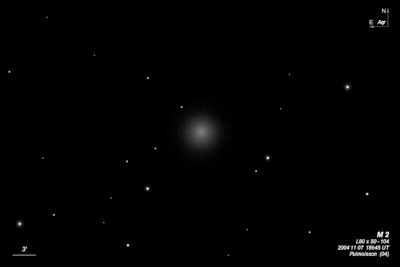
Jean-Dominique Maraldi discovered M2 = NGC 7089 = h2125 on 11 Sept 1746 at the Paris Observatory while tracking Comet de Chéseaux of 1746. Charles Messier made an independent discovery on 11 Sep 1760. William Herschel observed the globular on 31 Jul 1783 with his 12-inch (small 20-foot) and commented "I can count 18 or 20 of the stars." Using his 18.7" on 12 Aug 1785 (sweep 425), he recorded "an extremely rich, very compressed and very brilliant cluster of extremely small stars, 7 or 8' in diameter. The stars are plainly to be seen, especially on the borders where they are not so condensed." On 4 Sep 1799 he observed M2 with the 48-inch (40-foot), and logged "It appeared very brilliant and luminous. The scattered stars were brought to a good, well determined focus, for which it appears that the central condensed light is owing to a multitude of stars that appeared at various distances behind and near each other. I could actually see and distinguish the stars even in the central mass. The Rev. Mr. Vince, Plumian Profession or Astronomy at Cambridge, saw it in the same telescope as described."
On 12 Sep 1830 (sweep 288), JH reported "A most superb cluster; round; stars eS; 12, 13, 14m; they are evidently globularly arranged, and not internally condensed towards the centre more than the spherical form would make them appear to be; but in the middle they blend into a blaze of light. It is like a heap of fine sand! With 9 inches aperture I can just see the stars; with 6 it is resolvable."
200/250mm - 8" (10/4/80): intense core, faint halo. Faint stars are resolved in the outer halo.
300/350mm - 13" (7/16/82): high resolution at edges, partially resolved core, symmetrical halo.
400/500mm - 17.5" (8/2/86): over 100 stars resolved over the entire disc at 286x. Superb view at this magnification.
900/1200mm - 48" (10/26/11): hundreds of relatively bright stars resolved in this large, beautifully symmetric globular. The intensely bright core is overlaid with a mat of resolved stars.
Notes by Steve Gottlieb
M 72
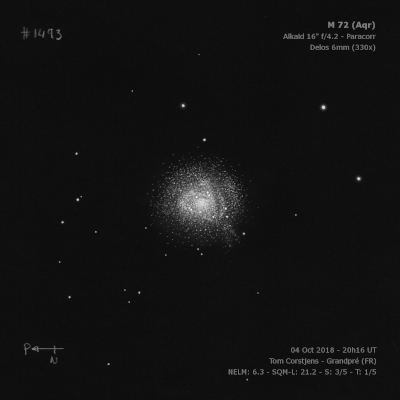
Pierre Méchain discovered M72 = NGC 6981 = h2090 on 30 Aug 1780. First observed by Herschel on 28 Sep 1783 using his 8-inch (10-ft focal length) and noted as "fairly resolved into small stars." WH made a detailed observation on 30 Oct 1810 using the 40-foot telescope (48-inch): Having been about 20 minutes at the telescope to prepare the eyes properly for seeing critical objects, the 72nd of the Connois came into the field. It is a very bright object. It is a cluster of stars of a round figure, but the very faint stars on the outside of these sorts of clusters are generally a little dispersed so as to deviate from a very perfect circular form; the telescopes which have the greatest light shew this best. It is very gradually extremely condensed in the center, but with much attention even there the stars may be distinguished. Power 280x. There are many stars in the field of view with it, but they are of many magnitudes and totally different from the excessively small ones that compose the cluster. It is not possible to form an idea of the number of stars that may be in such a cluster, but I think we cannot estimate them by hundreds. The diameter is about 1/5 of the field = 1' 53".6." John Herschel also resolved this cluster on 4 Oct 1825: "F; R; gbM; resolved into very small stars; 2 or 3' diam."
300/350mm - 13.1" (9/29/84): very mottled non-symmetrical appearance with a bright core. Roughly a dozen stars are resolved mostly on the east side of the core. A brighter mag 13.5 star is in the NE side of the halo.
400/500mm - 17.5" (7/17/01): at 380x, the halo is very irregular and the globular has a very uneven surface brightness. The non-symmetrical halo is elongated ~E-W, perhaps 4'x3'. The brighter 1.5' core is covered with a sprinkling a 8-10 faint stars. From the core there are short ragged extensions to the SW and NW with a few resolved stars. More prominent is a nearly detached clump on the east side which is extended ~N-S and contains roughly 8 easily resolved stars over haze. In total, perhaps two dozen stars are resolved in moments of good seeing.
17.5" (8/13/88): very mottled at 280x, 3' diameter. About 20 stars are resolved at the edges and over the core.
17.5" (8/2/86): very mottled, ragged irregular appearance. 15-20 stars resolved over the disc.
Notes by Steve Gottlieb
NGC 7009
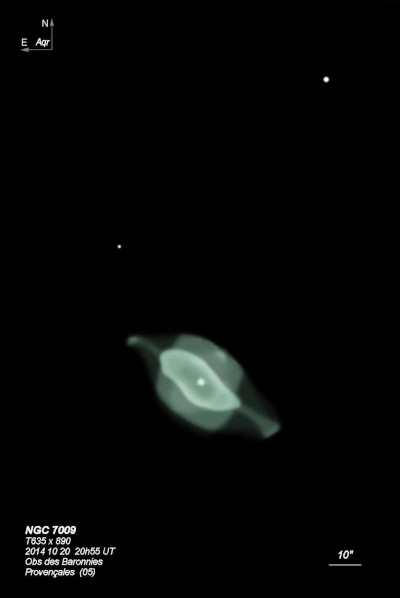
William Herschel discovered NGC 7009 = H IV-1 on 7 Sep 1782, over a year before he began his sweeps, while still reviewing naed-eye stars and discovering double stars. This was Herschel's first documented deep sky discovery (Wolfgang Steinicke found an unpublished discovery of NGC 6535 on 24 Aug 1780 while he inspected the Flamsteed stars). It was found with either his 6.2-inch or his 12-inch f/20 reflector ("small 20-foot") built in 1776 to survey the Messier objects. He described "a curious nebula, or what else to call it I do not know. It is of a shape somewhat oval, nearly circular, and with this power [460] appears to be about 10 or 15" diameter. It is of the same shape with 278 but much less in appearance. With 932 it is still the same shape but much larger. So that its appearance seems to follow the law of magnifying, from whence it is clear that it is of some real magnitude in the heavens and not a glare of light. The brightness in all the powers does not differ so much as if it were of a planetary nature but seems to be of the starry kind, tho' no star is visible with any power. It is all over of nearly the same brightness. The compound eyepiece will not distinguish it from a fixt star, at least not sensibly...". He observed the planetary during 6 sweeps with his 18.7" and on 2 Aug 1788 (sweep 851) logged, "The planetary nebula, considerably oval, in the direction of the parallel nearly. Of a bluish light, but not very well defined."
Wilhelm Struve independently found NGC 7009 (∑ 8) in 1825 or 1826 with the 9.6-inch Great Dorpat refractor. It was included in his list of 9 "Nebulae dectae" in an appendix to his main catalogue of double stars. Auwers and d'Arrest measured accurate positions. Lord Rosse, Romney Robinson and George Johnstone Stoney observed the planetary on 23 Oct 1848 resulting in a sketch (by Stoney) and description, "we have not detected any perforation, but it has ansae, which probably indicate a surrounding nebulous ring seen edgeways".
Stoney or Rosse made another observation on 16 Aug 1849 and measured the "position of ring taken with an eyepiece furnished with a level and a position circle. Inclination of ring to horizon 9°." Although the nickname "Saturn Nebula" was not mentioned in Robinson's report to the Royal Irish Academy, the description in the 1880 publication (given as 16 Sep 1849) states, "Saturn neb. Pos of ring 81 deg".
Using a 9.5" refractor in 1856, Father Secchi sketched NGC 7009 and noted the nebula was fainter at the ends of the major axis and brighter along the north and south sides (AN 43, 157).
In 1867 Lassell reported his "Observations with the Four-foot Equatoreal at Malta" and his description from 23 Aug 1862 begins "My first impression of this Nebula was that it was a sky-blue likeness of Saturn". In a letter dated 26 Sep 1862, he goes into much more detail: In directing my large equatoreal upon the well-known planetary nebula situated in AR 20h 56m N.P.D. 101° 56' (1862), it has revealed so marvellous a conformation of this object that I cannot forbear to send you a drawing of it [see www.docdb.net/history/texts/display.php?article=1863rsps___12__269l], with some description of its appearance. With comparatively low powers, e.g. 231and 285, it appears at first sight as a vividly light-blue elliptic nebula, with a slight prolongation of the nebula, or a very faint star, at or near the ends of the transverse axis. In this aspect the nebula resembles in form the planet Saturn when the ring is seen nearly edgewise. Attentively viewing it with higher powers, magnifying respectively 760, 1060, and 1480 times, and under the most favourable circumstances which have presented themselves, I have discovered within the nebula a brilliant elliptic ring, extremely well defined, and apparently having no connexion with the surrounding nebula, which indeed has the appearance of a gaseous or gauze-like envelope, scarcely interfering with the sharpness of the ring, and only diminishing somewhat its brightness. This nebulous envelope extends a little further from the ends of the conjugate than from the ends of the transverse axis; indeed, it is but very faintly prolonged, and only just traceable towards the preceding and following stars....
Lassell's sketch shows the two ansae or handles as faint stars but the outer halo does not extend as far as the ansae. Hermann Vogel produced an excellent sketch on 20 Sep 1883 using the 27" refractor at Vienna. Besides the prominent inner elliptical ring and an oval darker central hole, the outer halo extends ENE-WSW and tapers on the ends with a star-like knot on the WSW end.
200/250mm - 8" (10/13/81): bright, small, blue-green, high surface brightness. Rays extending outward are suspected, particularly on the western side in excellent seeing at 200x.
300/350mm - 13.1" (9/3/83): similar view to 17.5", but the eastern extension was more difficult to view.
400/500mm - 17.5" (8/10/91): extremely bright, fairly small, very high surface brightness, blue-green color, about 30" diameter to the main oval body. At 412x, the two famous extensions or "jets" are easily visible extending WSW-ENE from the oval disc using direct vision. The western extension is brighter and a very small knot (ansae) is visible at moments with concentration at the tip of the west extension. A faint outer shell surrounds the bright disc. Numerous additional observations made since 9/14/85.
600/800mm - 24" (7/25/14): viewed at 1000x in good seeing at Lassen National Park (elevation 8200 ft). The intense, inner annulus is 30"x18" with a bright, moderately thick green rim and darker center. The central star was nearly visible steadily within the darker center. The oval annulus was slightly irregular in surface brightness. It was surrounded by a rounder, fainter envelope, which varied slightly in brightness, particularly on the north side, which contained a noticeable knot. The fairly narrow jets were readily visible, though brighter on the west side. An obvious knot ("ansa") that was slightly elongated was visible at the tip of the western jet. The eastern extension only had a weak brightening at the tip.
900/1200mm - 48" (10/29/16): the remarkable Saturn Nebula was viewed at 1084x. The intense, inner "ring" is very elongated (~25"x10") with an unusual warped appearance. The inner ring is brighter on the west end. The rounder shell extends ~30"x25", slightly elongated WSW-ENE and contains an obvious "knot" on the north side of the shell. The ansae ("handles" at the end of the jets) varied in size and orientation, with the western ansae larger, brighter and angled outward on the north end. The central star was easily visible.
48" (10/24/14): at 610x; the western ansae or "handle" at the end of the jet appeared as a small, narrow bar, roughly perpendicular to the extension, but slightly tilted, so the north end was pointing outward (west). The eastern ansae was much smaller but with careful viewing was slightly elongated and tilted in a mirrored orientation. Also, a very small, low contrast knot was noted on the north end of the outer shell. Otherwise, the details mentioned in the observation from last November were all noted.
48" (11/1/13): the double-shell structure was fascinating at 813x. The bright, inner ring was surprisingly elongated WSW-ENE, ~30"x10", with an irregular surface brightness and uneven thickness. The inner darker hole was also elongated, extending nearly the length of the nebula and was punctuated by a fairly easy central star. This annulus is encased in a rounder, outer shell, ~30"x25" diameter, with a slightly irregular rim (brighter at the north edge). Extending from the main body were the two easily visible "jets" extending WSW-ENE with prominent "ansae" (handles) at each tip [separation 44"] with the western tip slightly brighter. The color was generally greenish, though the outer halo had a salmon-colored tinge.
Notes by Steve Gottlieb
M 73
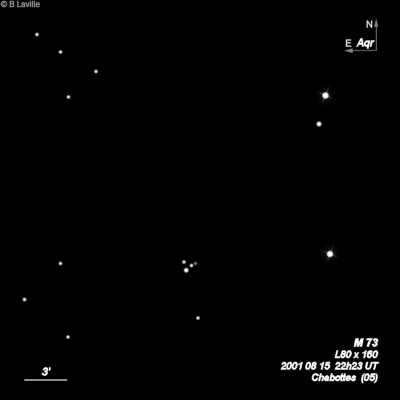
Charles Messier discovered M73 = NGC 6994 on 4/5 Oct 1780 and recorded a "Cluster of three or four small stars, which resembles a nebula at first sight, containing a little nebulosity." On 28 Sep 1783 during his Messier survey, WH noted "consists of a few stars in a triangular form. No nebulosity among them." (10-foot, 150x).
The Hipparcos data places the four stars at different distances, so this is an optical quadruple -- a true asterism.
200/250mm - 8" four stars mag 10.5, 10.5, 11.0 and 12.0 in a small group, easily resolved at 100x.
400/500mm - 17.5" (9/7/91): four stars in a "Y" asterism. On the west side are the two fainter stars mag 11.5 and 12 oriented WNW-ESE which form the stem of the "Y". A mag 10 star is on the SE branch and a mag 10.5 star is on the NE branch. This is an unimpressive asterism.
Notes by Steve Gottlieb
NGC 7727
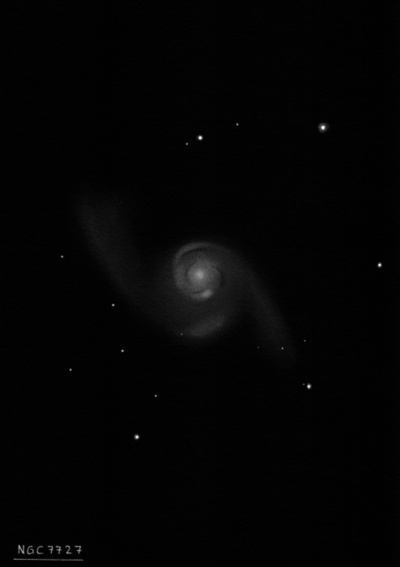
William Herschel discovered NGC 7727 = H I-111 = h2262 on 27 Nov 1785 (sweep 478) and recorded "pB; pL; bM; iR." His position is unusually accurate. d'Arrest made two observations, measured an accurate position, and gave the diameter as 37"-42".
200/250mm - 8" (8/28/81): faint, moderately large, round, bright core.
300/350mm - 13" (10/10/84): moderately bright, bright core, faint stellar nucleus, faint outer halo, slightly elongated. Forms a pair with NGC 7724.
400/500mm - 17.5" (9/15/90): fairly bright, moderately large, oval 4:3 E-W, very bright core, almost stellar nucleus, large fainter halo. Forms a pair with NGC 7724 12' NW.
Notes by Steve Gottlieb
NGC 7606
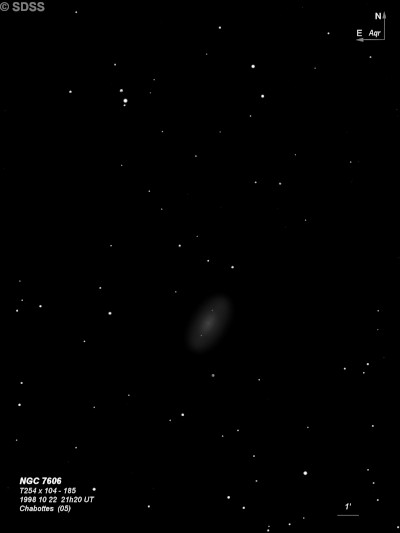
William Herschel discovered NGC 7606 = H I-104 = h2228 = h3982 on 28 Sep 1785 (sweep 445) and recorded "cB, cL, gmbM, nearly in the meridian, each end seems to terminate in a very faint ray." From the Cape of Good Hope, JH reported "F; pL; pmE; 2' l, 1 1/2' br." On 18 Sep 1852, G. Johnstone Stoney, observing with LdR's 72", logged "seemed narrowest in the middle and to spread out at either end, a small star nnp nucl on edge of neby. Query, a brighter streak f nucl from np to sf [probably the eastern spiral arm]."
Based on a photograph taken at the Helwan observatory in 1919-20, NGC 7606 was described as "a fine compact spiral with dark lanes between the whorls, bright almost stellar nucleus."
200/250mm - 8" (11/8/80): faint, elongated.
300/350mm - 13.1" (11/5/83): fairly bright, large, elongated 2:1 NNW-SSE, weak concentration, diffuse halo, possible faint stellar nucleus. Bracketed between two mag 12/13 stars that lie 3' N and 2.5' S of center.
Notes by Steve Gottlieb
NGC 7184
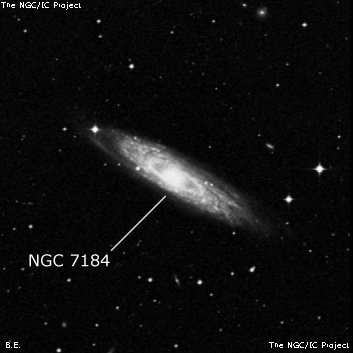
William Herschel discovered NGC 7184 = H II-1 = h2143 on 28 Oct 1783, the first night of his systematic sweeps! (internal discovery #1). He was using the "front-view" mode without a secondary (first 41 sweeps). He made another observation on 13 Oct 1786 (sweep 609, starting again using the front-view): "F, mE, er, making an angle with two pairs of stars, which are situated in a line from np to sf. The nebula is also followed by a small star, which continues the angle the nebula makes with the two pairs of stars." JH made the single observation on 23 Sep 1830, "pB; pL; vmE; position = 64.3°; psvlbM; 2' long." On 7 Sep 1850, George Stoney (LdR's assistant) reported seeing 4 knots or faint stars in the nebula.
Photographs taken with the 30-inch reflector at the Helwan observatory in Egypt in 1919-20 revealed "spiral with rather compact but well defined whorls [spiral arms] and a B sharp stellar nucleus surrounded by a rather brighter patch of nebulosity. Ther are signs of absorption in the northwest portion."
200/250mm - 8" (8/28/81): faint, fairly large, edge-on, narrow.
400/500mm - 17.5" (10/12/85): bright, large, very elongated WSW-ENE with long faint extensions 5'-6' length, small bright core. A mag 12 star is off the NE edge. In a group with NGC 7180, NGC 7185 and NGC 7188.
Notes by Steve Gottlieb
NGC 7377
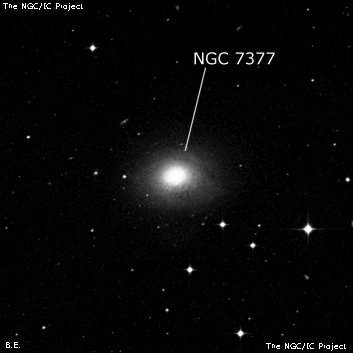
William Herschel discovered NGC 7377 = H II-598 = h2181 on 13 Oct 1786 (sweep 609) and recorded "pB, pL, iR, vgmbM." The observation was using the "front-view" configuration (adopted as the primary method after earlier experiments) at the edge of his tube, bypassing the need for a secondary. John Herschel made three additional observations.
200/250mm - 8" (9/25/81): faint, small, round, diffuse. Two mag 9 stars 6' NNW and 10' N are aligned N-S.
400/500mm - 17.5" (10/5/91): fairly bright, fairly small, slightly elongated ~E-W, 1' diameter, gradually increases to a small bright core. A group of stars lies south and mag 8.5 SAO 191412 is 11' N.
Notes by Steve Gottlieb
NGC 7492
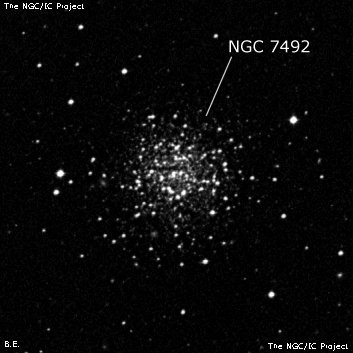
William Herschel discovered NGC 7492 = H III-558 = h2208 on 20 Sep 1786 (sweep 595) and recorded "eF, cL, iR. By changing and wiping the eye glasses, I saw it with both so as to leave no doubt. 5 or 6' dia." JH called this cluster "eF; vL; 2 or 3'; the faintest thing imaginable; half way between two coarse double stars in the same parallel."
200/250mm - 8" (8/2/81): very faint, diffuse, moderately large, no resolution. Very low surface brightness for a NGC globular and difficult with this aperture.
400/500mm - 17.5" (8/1/86): faint, large, round, diffuse, no resolution.
600/800mm - 24" (11/24/14): picked up at 200x as a faint, large, low surface brightness glow with a very weak concentration, 4'-5' diameter. At 375x, a few resolved stars shone steadily and quite a number popped in/out view consistently. Perhaps two dozen were intermittently resolved, though the surface was too lively (particularly with averted vision) to count reliably. These are the brightest red giant members and range from mag 15.5 to 16+.
Notes by Steve Gottlieb
NGC 7252
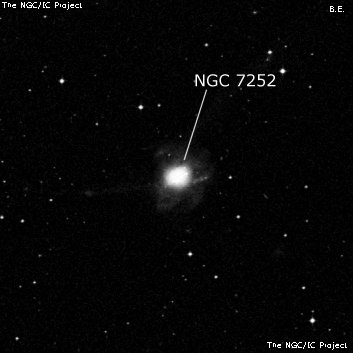
William Herschel discovered NGC 7252 = H III-458 = h3934 on 26 Oct 1785 (sweep 465) and recorded "vF, S, er. 240 confirmed it with difficulty." His position is at the north edge of the galaxy. JH made the single observation "Not vF; S; R: bM; 30"."
300/350mm - 13.1" (9/9/83): fairly faint, very small, round, compact, weak concentration. Located 40' WNW of 49 Aquarii (V = 5.5).
Notes by Steve Gottlieb
NGC 7585
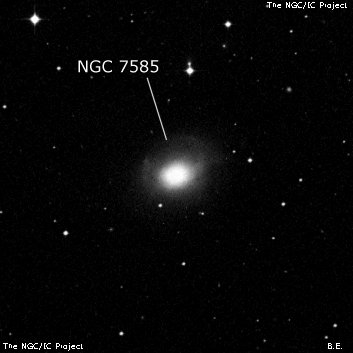
William Herschel discovered NGC 7585 = H II-236 = h2226 = h3979 on 20 Sep 1784 (sweep 279) and noted "pB, irr E, r." On 5 Oct 1785 (sweep 455) he noted "pB, pL, iR, mbM." JH made an observation from Slough as well as the Cape of Good Hope (accurate position).
200/250mm - 8" (9/25/81): faint, small, small bright nucleus. Two mag 8 stars are in the field to the north and NW.
400/500mm - 17.5" (8/7/91): bright, moderately large, elongated 3:2 WNW-ESE, small very bright core, stellar nucleus. Located 8.0' SSE of mag 8.5 SAO 146621. Forms a pair with NGC 7576 10.7' SW. NGC 7592 lies 15' NE.
Notes by Steve Gottlieb
NGC 7284
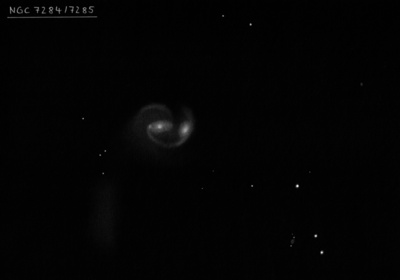
William Herschel discovered NGC 7284 = H II-469 = h3943 on 26 Oct 1785 (sweep 465) and recorded "F, er [easily resolvable] or some of the stars visible; pS, lE." Perhaps one the "stars" was the second nucleus (NGC 7285). From the Cape of Good Hope, JH logged (sweep 474) "F; E; bM; r; binuclear pos 62.3°. Rather an equivocal object, whether nebulous or a group, but I incline to regard it as a nebula." On a later sweep (14 Sep 1835), he wrote "pB; irr R; 25"; involves a double star (13m + 14m)." So, he clearly resolved the two nuclei.
Herbert Howe reported NGC 7284 and 7285 as follows: "The description of 7284 in the NGC is "cF, cS, lE, r, D * inv." The description of 7285, discovered by Lassell [Marth], is "Nebs. * 1' dist from 7284." I judge 7285 to be simply one of the components of 7284. Both seem to be nebulous stars. The brighter one is of mag 12.5 The other is of mag 13, and lies at P.A. 60°, distant about 40". Neither of the stars appeared to be double. I could not see any nebulosity uniting them, but the sky was rather dull."
400/500mm - 17.5" (10/13/90): fairly faint, very small, very compact, almost round, high surface brightness, very small very bright core, stellar nucleus. Forms a contact pair with NGC 7285 at the ENE edge with a separation of 30" between centers.
600/800mm - 24" (8/23/14): at 375x, the western component of the double system VV 74 = Arp 93 appeared bright, small, round, high surface brightness, ~0.4' diameter. The core of NGC 7285 is cleanly resolved [33" between center], though very close northeast. The twin nuclei are encased in a very low surface brightness halo.
Notes by Steve Gottlieb
NGC 6962
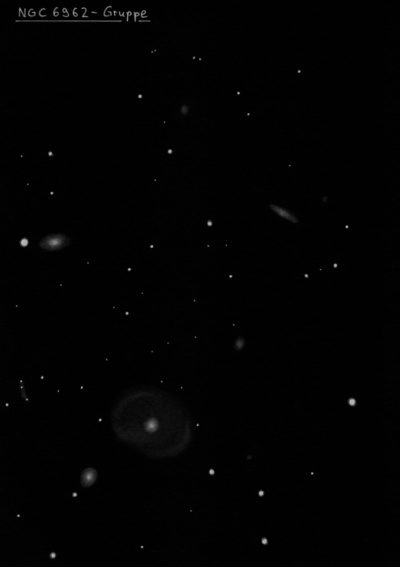
William Herschel discovered NGC 6962 = H II-426 = h2087, along with NGC 6964, on 12 Aug 1785 (sweep 425) and recorded "Two, the preceding [NGC 6962] F, S, iR, mbM... 240 showed the same. The time and NPD is that of the preceding." His position is within the halo. On sweep 81, John Herschel logged "pF; S; R: gbM; 15...20"." His mean position (2 measures) is accurate.
Based on Helwan Observatory photos (1914-16), NGC 6962 was described as "vF, 2.5'x2.0', lE 60°, open spiral with bright nucleus."
300/350mm - 13.1" (7/27/84): fairly bright, fairly small, small bright core, almost round. Largest and brightest in a group.
400/500mm - 17.5" (7/16/88): brightest in the NGC 6962 group. Moderately bright, fairly small, round, bright core, stellar nucleus. On a line with NGC 6964 1.8' SE and NGC 6961 3.3' NW. Also forms an equilateral triangle with NGC 6959 7.1' NW and NGC 6967 6.6' NE.
17.5" (8/31/86): moderately bright, roundish, strong bright core, stellar nucleus.
600/800mm - 24" (9/25/19): at 375x; bright, moderately large, slightly elongated ~E-W. Sharply concentrated with a very bright core, ~40" diameter, with an intense nucleus. I initially noticed only the central region, but lowering the power to 200x there appeared to be a very large, low surface brightness halo, extending ~2.5' diameter. A mag 14.5 is at the W edge, 1.4' from center, and a similar star 1.7' E of center. Brightest of 4 NGC galaxies and 8 overall in the group.
Notes by Steve Gottlieb
NGC 7309
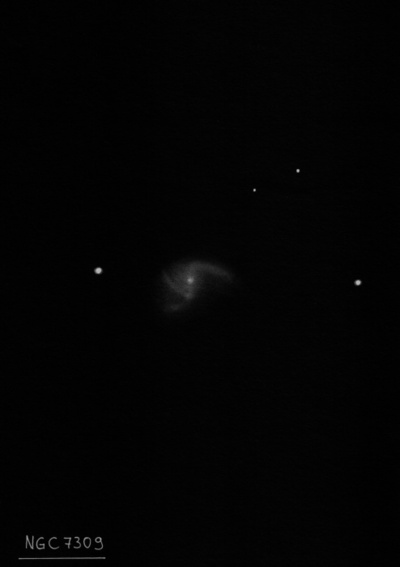
William Herschel discovered NGC 7309 = H II-476 = h2167 on 28 Nov 1785 (sweep 479) and recorded "F, pL, iR, lbM." JH made 5 observations, first reporting it on 9 Sep 1825 (sweep 9) as "F; R; vgbM; r; 2'." R.J. Mitchell, observing at Birr Castle on 2 Oct 1856, reported "has a * near center and I suspect a * or knot in np edge [spiral arm at this end]."
Heber Curtis described the photograhic appearance in 1913 based on Crossley plates at Lick as "a small nebula about 1.5' in size, of very unusual form. Has faint stellar nucleus; ther are three fainter nuclei from which spring short whorls [spiral arms]; these are not arranged as in an ordinary spiral, but overlap." At the Helwan observatory in Egypt, it was described (1921) as a "3 branched spiral with sharp stellar nucleus. The north branch starts from a faint almost stellar condensation just n.f. the nucleus. The branch just south of the nucleus forms an oval around it, much brighter on the south side. The third branch is also south and curiously broken in the middle."
300/350mm - 13.1" (9/3/83): faint, moderately large, very diffuse, slightly elongated ~E-W, even surface brightness.
600/800mm - 24" (8/14/15): moderately bright and large, irregular shape, slightly elongated, ~1.0'x0.8', contains a small bright core. A fairly thin spiral arm juts out to the west on the north end. On the DSS, this spiral has a second strong arm off the south end, extending east, though this arm was difficult to distinguish.
Notes by Steve Gottlieb
NGC 7393
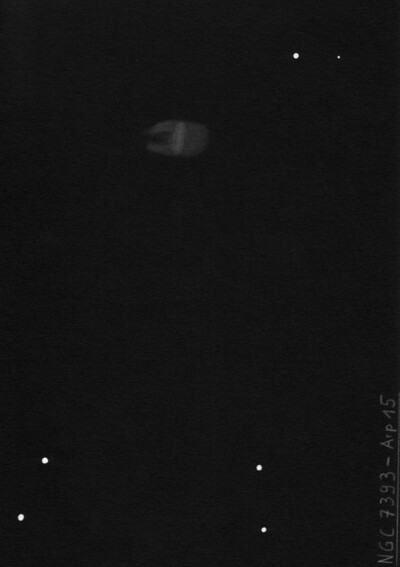
William Herschel discovered NGC 7393 = H II-453 = h2187 on 5 Oct 1785 (sweep 455) and recorded "F, pL, E in the parallel [E-W], r." JH logged it as "eF; R; vgbM; sky dull." and measured an accurate position.
400/500mm - 17.5" (9/15/90): fairly faint, fairly small, elongated 3:2 E-W, broad concentration.
Notes by Steve Gottlieb
NGC 7592
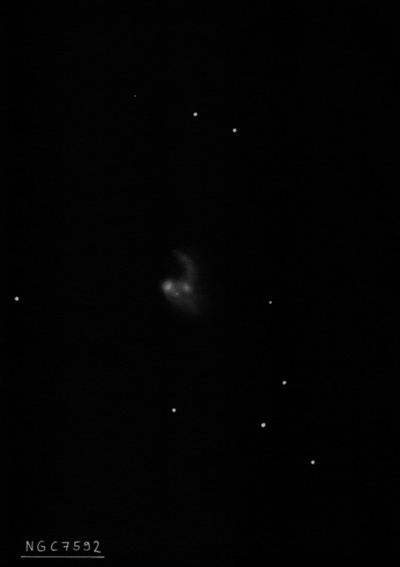
William Herschel discovered NGC 7592 = H III-186 on 20 Sep 1784 (sweep 279) and noted "eF and vS." Heinrich d'Arrest measured an accurate micrometric position on 2 Oct 1866.
400/500mm - 17.5" (8/7/91): faint, small, round. NGC 7592A, a very faint and extremely small companion (only the nucleus was observed) attached at the west edge, was just resolved. NGC 7585 lies 17' SW. This is an interacting/colliding pair on the POSS with nuclei only 15" apart!
600/800mm - 24" (8/23/14): at 375x appeared fairly faint, fairly small, irregular. The component with the highest surface brightness is the core of the eastern galaxy (NGC 7592B = 7592E). Most of the glow extended southwest (NGC 7592C = 7592S) and created an asymmetric appearance. The nucleus of the western galaxy (NGC 7592A =7592W) appeared faint and extremely small, perhaps 5" diameter. The arm or wing to its north was not seen. The two nuclei are separated by only 13". The nucleus of the third southern component, which wasn't seen, is probably a large HII clump in NGC 7592E. The western galaxy has a Sy2 nucleus.
900/1200mm - 48" (10/29/19): NGC 7592 is an interacting, merged pair with a separation of only 13"! At 610x the western component (NGC 7592 W) appeared moderately bright, small, round, with a sharp stellar nucleus. A low surface brightness tidal arm was attached on the west side and it hooked to the north. The brighter eastern galaxy (NGC 7592 E) was fairly bright, fairly small, roundish, ~25" diameter, very bright core offset towards the north side. A very small HII knot, 6"-8" diameter, called NGC 7592 S, is at the southwest end [13" from center]. A very low surface brightness halo extended further southwest of 7592 E and directly south of 7592 W. This section is probably part of another tidal tail.
Notes by Steve Gottlieb
NGC 7656
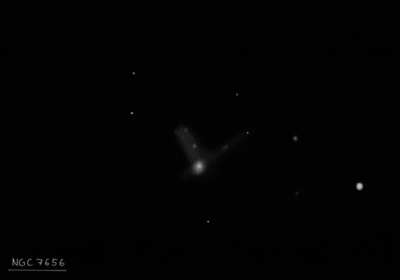
Francis Leavenworth discovered NGC 7656 = LM 1-263 on 9 Oct 1885 and recorded "vF; vS; R; bMN." There is nothing at his rough position (nearest min of RA), but approximately 1 minute of RA west is ESO 605-005 = PGC 71357. Herbert Howe measured an accurate position in 1897-98 (repeated in the IC 2 Notes). Bigourdan couldn't find this object, probably looking at the wrong position.
400/500mm - 17.5" (10/21/95): very faint, small, round, 30" diameter. Contains a very small brighter core surrounded by a very faint halo. This is an unusual, distorted interacting system with loops and filaments, though no structure was seen.
600/800mm - 24" (9/30/16): at 282x; fairly faint, fairly small, slightly elongated, 20" diameter, contains a small slightly brighter nucleus. ESO 605-004, 13' WNW, appeared very faint, fairly small, roundish, 20" diameter, low even surface brightness. ESO 605-006, 14' NE, was only occasionally glimpsed as an extremely faint glow, small, ~15" diameter, possibly elongated. The trio is catalogued as KTS 72 (Karachentsev Triplets, South).
24" (8/23/14): fairly faint, fairly small, round, 20"-24" diameter, weak concentration. The loop structure to the northeast was not noticed. ESO 605-004 lies 13' WNW.
900/1200mm - 48" (11/1/13): at 488x and 610x appeared fairly faint to moderately bright, round, ~24" diameter, high surface brightness. Surprisingly, a low surface brightness wing or loop extending to the northeast was immediately noticed. This loop is brighter along the northern edge and passes through a mag 16.7 star (or stellar galaxy), increasing the overall length to 45" extending southwest (core) to northeast (loop). A mag 16.5 star lies 1.3' W and another mag 16.5 star is 1.4' N. 2MASX J23242536-1902139, an extremely compact galaxy (V = 15.7) lies 1.9' NW. Finally, 2MASX J23243030-1903019, an extremely faint quasi-stellar galaxy was glimpsed less than 30" NNW, although another loop in that direction was not seen.
Notes by Steve Gottlieb
HCG 88
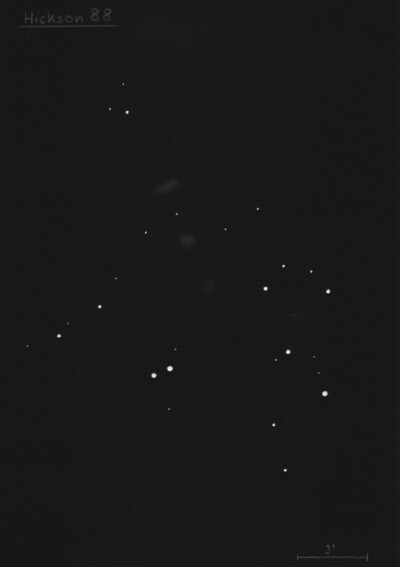
| Type | GALCL [S3] |
| RA | 20:52:22.8 |
| Dec | -05:45:28.0 |
| major_axis | 6.8' |
| mag | 11.3 |
| surface_bright | 99.9 |
HCG 89
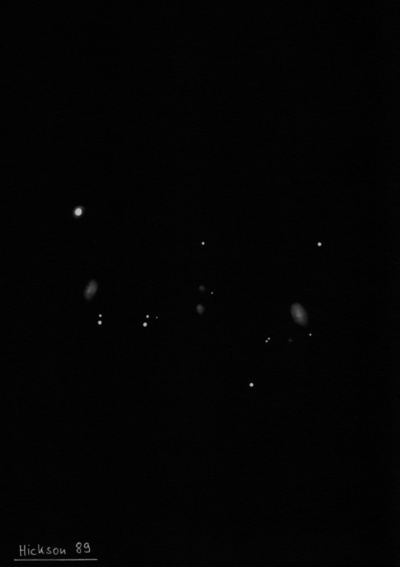
| Type | GALCL [S2] |
| RA | 21:20:10.8 |
| Dec | -03:54:32.0 |
| major_axis | 6.2' |
| mag | 13.7 |
| surface_bright | 99.9 |
PGC 65367
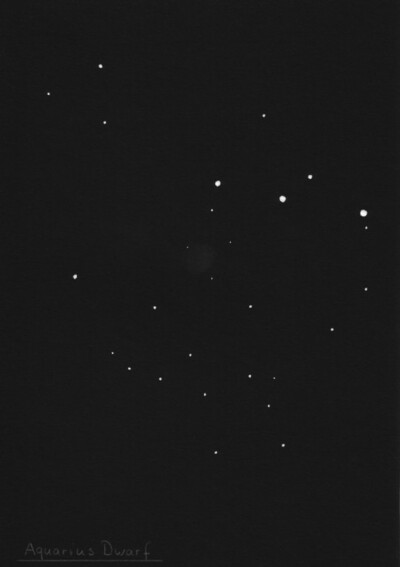
| Type | GX [Irr] |
| RA | 20:46:51.7 |
| Dec | -12:50:52.0 |
| major_axis | 2.2' |
| minor_axis | 66.0'' |
| position_angle | 112.0 |
| mag | 14.2 |
| surface_bright | 14.7 |
